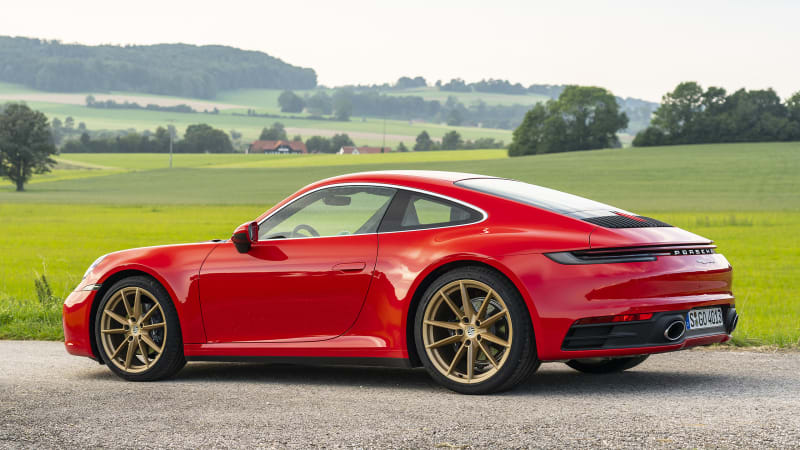2020 Porsche 911 Carrera First Drive Review | When less is … not much less
https://ift.tt/2NDlHq4
STUTTGART, Germany — It may be slotted beneath the Carrera S models that ushered in the 992-series 911, but the new base 2020 Porsche 911 Carrera is by no means an inferior sports car. Furthermore, this lower-priced, less powerful model just might be the one you want. And you don’t have to give up as much from the ‘S’ models as you’d think.
Consider the cold, hard numbers produced by both vehicles’ 3.0-liter, twin-turbocharged engines – the 2020 Porsche 911 Carrera S produces 420 horsepower and 443 lb-ft of torque, while the base Carrera makes 379 hp and 331 lb-ft. – a difference of 41 hp and 112 lb-ft. But the regular Carrera actually makes peak torque 400 rpm earlier, holding it from 1,900 rpm all the way to 5,000 rpm. It also has 28 fewer pounds to haul around (3,354 in total) due to smaller wheels (19-inches up front, 20 in the back) and lighter turbochargers. The S’s 20/21-inch wheels package is optional.
For you 0-60 mph obsessives, a best-case-scenario showdown between Carrera and Carrera S, both packing a PDK with the Sport Chrono setup, yields only a one-tenth-of-a-second difference between the two – 3.7 seconds for the ‘S’, and 3.8 seconds for the base car. Without, the Carrera hits 60 mph in 4.0 seconds.



Walk up to the new standard 911, and unless you sneak a peek at the tail badging, you’ll likely have a hard time distinguishing the $98,750 Carrera from its $114,650 ‘S’ stablemate. This is the first time Porsche has wrapped both rear-drive and all-wheel drive variants in the same widebody configuration, and the Coke bottle stance and staggered wheels lend the 2020 base model a strong visual presence. In fact, from the outside the only visual distinction (other than badging) is the twin rectangular exhausts of the Carrera, compared to the quad round outlets on the S.
Both 911s also share the same interior, which continues the familiar Porsche theme of a big central tach (which is thankfully still analog), this time flanked by twin digital displays whose views are easily blocked by the steering wheel. An updated seat is supportive and comfortable, and the centrally positioned, 10.9-inch touchscreen offers plenty of real estate for menu tapping and pinch zooming. The stubby, knurled PDK shift lever that sits atop the center console is a little unusual, but Porsche brass intimated that they’ll update us on the yet-unreleased manual option soon.



Click the shifter into drive, and there’s sometimes a small amount of perceptible clutch grabbiness during low-speed creeps. Apply your inputs deliberately however, and the 911 tends to surge ahead with easy thrust. A sport exhaust button on the center console produces moderately louder sounds at low rpm that became considerably deeper and richer at around 4,500 rpm. There’s typically not a whole lot of waiting as the engine blasts towards the indicated 7,400 rpm redline.
Gearchanges are smooth in Normal mode, but there’s more urgency in Sport, and a sharp but not disruptive jab in Sport Plus. Press the “M” button on the center console to take full control over shifts via two small steering wheel-mounted paddles. Wait too long or miss a shift, and the tach bounces off the rev limiter, just as it should. Frankly, if you’re remiss in tapping the paddles, you have no one to blame but yourself: Though small in size, the paddles are crisply responsive with virtually no lag time between finger tap and cog swap.



There’s a similarly responsive feeling to every driver input, a tactile sensation. The Carrera is comfortable enough to drive all day, but communicative enough to keep you from feeling isolated from your surroundings. Because the German roads we maneuvered were almost annoyingly perfect and lacking potholes, it was hard to know how the suspension would react to pockmarked or rippled surfaces. As it was, selecting the stiffer shock setting revealed slightly more busyness from all four wheels, though not enough to trigger annoyance or fatigue. In fact, the 911 Carrera’s road manners are so well-tempered that it might seem more of a grand tourer than a sports car.
The new Carrera Cabriolet ($111,550) takes a slight edge off the performance sharpness by letting in the atmosphere. Though responsive, the Cabriolet still faces some inherent limitations. With less torsional stiffness, the steering isn’t quite as crisp. And there’s more mass to haul around – 154 lbs gained over the coupe, for 3,508 in total. But when piloted at speed, the Cabriolet makes up for it with added sensory input — turbine whine echoing off a concrete divider, the wind tickling my shoulder. These are all beautiful distractions in the Cabriolet, though they do beg the question of whether the cabrio is as driver-focused as a serious enthusiast would want.



It’s hard not to develop warm fuzzies for the standard 911 Carrera coupe in particular. Much like the 991.2-series 911T proved to be more than the sum of its parts, the new base model Carrera carries with it a certain honest attraction and a minimal performance penalty despite its power deficit. Sure, spendy types will likely pay the extra $15,900 for the S, though I’d argue they won’t be getting nearly that much value out of its performance in return. The entry-level 911 proves to be more than enough car for virtually any situation, except for maybe a battle of numerical supremacy.
Auto Blog
via Autoblog https://ift.tt/1afPJWx
August 29, 2019 at 12:20PM
